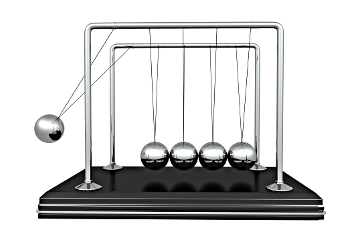Isaac Newton, born in 1643 and died in 1727, was a scientist from Britain who studied math, physics, and astronomy. He is widely regarded as one of the most influential scientists ever and is particularly known for his famous Three Laws of Motion in physics. You’ve probably learned about them in science class!
In 1686, Newton formulated three laws of motion that describe how forces affect the movement of an object, both when it is moving and when it is not. These laws, up to this day, still form the basis for the study of the motion and behavior of matter, which we call Classical or Newtonian physics. Keep in mind, Newton was the first person to have ever questioned these fundamentals!
But what are the three laws? Let’s talk about them!
Law 1: “An object at rest remains at rest, and an object in motion remains in motion UNLESS acted on by an unbalanced force.”
This law just explains that an object that is not moving will not move unless somebody provides a force to it. For example, if I have an apple sitting on my desk, it will not move by itself. The apple will only move if somebody, such as my mom, grabs it and moves it. Pretty simple, right?
However, this law also explains that something in motion will stay in motion. In fact, a moving object will stay moving at the same speed! For example, if I rolled my apple along the floor of my house, it SHOULD move forever at the initial speed I threw it, hitting the wall furthest in its path.
You might be saying, “But wait! That clearly can’t be right! The apple DOES stop!” and you ARE correct. This is because there actually is an external force. Friction, a force that resists the sliding or rolling of one solid object over another, is the unbalanced force that is responsible for bringing the rolling apple to rest. Friction is always present in every real-life situation. So something you might not expect could be the reason an object begins or stops moving.
Fun fact: the definition of inertia is the “tendency to do nothing or to remain unchanged”. Hence, Newton’s First Law is often called the Law of Inertia!
Law 2: “The force an object experiences is equivalent to the product of the mass of the object and the consequent acceleration.”
If we were to turn this law into a mathematical equation, it would be as follows: force applied = mass of object * object’s acceleration. Remember, acceleration is the change in the object’s speed per time. In short, f = m * a.
For example, if the mass of my apple is 2 kg (do note that this is highly unlikely) and it accelerates at 4 meters per second squared, the force I applied would be mass * acceleration = 2 * 4 = 8.
Just 8? 8 what? Bananas? Shoelaces?
No. The typical unit for force is named directly after the discoverer of these three laws: Newton himself! So the force I applied would be 8 Newtons.
Finally, just think about this law, because it makes sense! If you push a box that is not moving, it takes much more effort at the beginning to get it moving (your effort is the “force” in this case). After it reaches the desired speed, pushing the box becomes much easier. In fact, you don’t need to do anything to keep a moving block moving, as shown by Newton’s First Law. Forces only change the speed of the block, hence the equation f = m * a.
Law 3: “Every action force has an equal and opposite reaction force.”
What? What does that even mean?
This law is often the most difficult to understand. In simple terms, this law explains that forces come in pairs. Every action force, such as me pushing a box, results in a reaction force, namely the box pushing back at me.
In other words, single forces do not exist. Every force has a returning pair, no matter how small it may seem.
Here’s a fun experiment: find a friend and both sit in chairs with wheels. Start next to each other and push off of each other’s hands. You’ll notice that both of you guys move from the starting location. This is Newton’s Third Law in action: both of you guys experienced the force of the other person pushing you!
You might be wondering what the action-reaction pair for pushing an extremely large object is. For example, what’s the reaction pair when I push the wall of my house? The wall should accelerate, as Newton’s Second Law explains, but it doesn’t.
This is because the wall has a high mass, so as a result, it has less acceleration with the same force exerted. If you were extremely strong and were able to provide a high force, the wall would eventually stop giving a reaction force and break. Notice that during the entire time, you exert a force that has a reaction force! I don’t recommend trying to push the walls of your house to try and break them though.
All three of these laws have an important role in classical mechanics, and Newton undoubtedly changed the realm of science forever. I hope you enjoy these laws as much as I do!
← Back To Blogs

Who was Isaac Newton?
... and what were his three laws of motion?, Sun, Feb 12 2023

Newton inevitably changed science forever with his three laws of motion!
Quiz!
Question 1
What is the equation for Newton’s 2nd Law of Motion?
Select your answer:
Full Name:
Leaderboard:
| Name | Tries |
|---|

Who is Brandon?
Brandon wrote this article!
Hello! I’m Brandon Yang and I’m the Vice President of Organizational Development. I’m a high schooler who loves STEM and has been excelling in it since I was young. I also love volunteering and teaching. I hope others can have a great STEM education, and I’m glad to be a part of the team to make that happen!